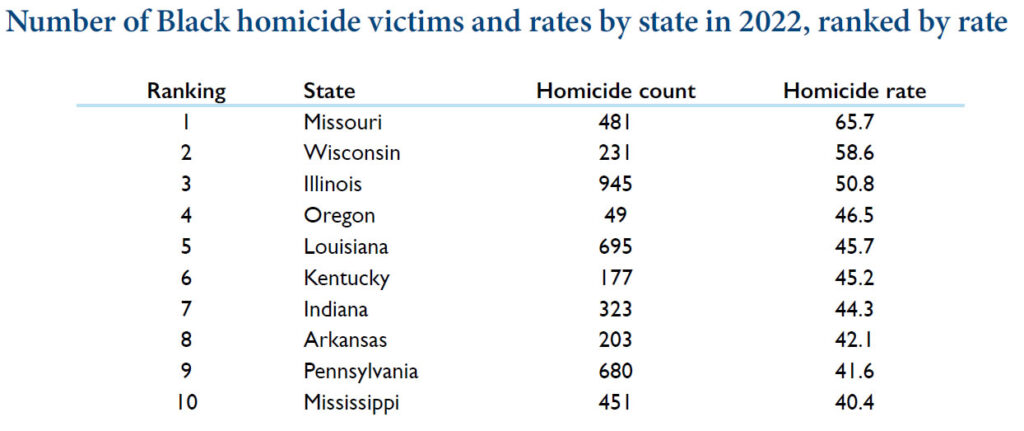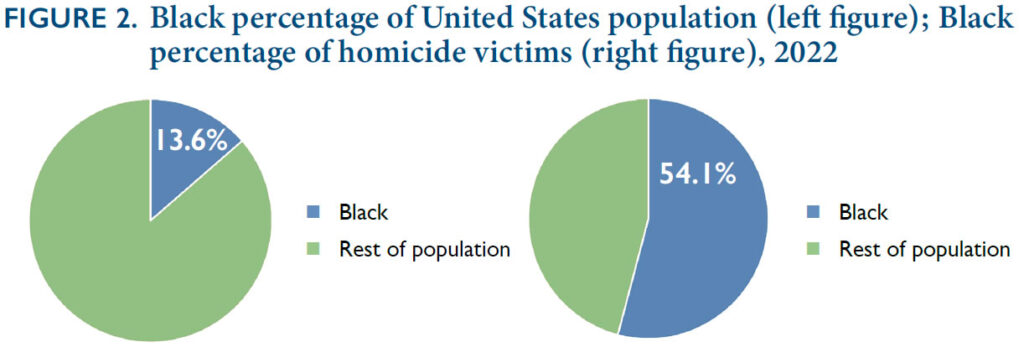For Release: Tuesday, July 9, 2024
Missouri has Highest Rate of Black Homicide Victimization in the Nation
Washington, DC — Guns are by far the most common weapon used to kill Black homicide victims in America according to Black Homicide Victimization in the United States: An Analysis of 2022 Homicide Data, a new study from the Violence Policy Center (VPC). The study shows that in 2022 there were 13,466 Black homicide victims in the United States and that 87.4 percent of these victims were killed with guns. Black Americans represented 13.6 percent of the U.S. population that year yet accounted for 54.1 percent of all homicide victims.
“The toll gun homicide exacts on Black men, women, boys, and girls is a national shame that demands action. The resulting devastation ravages families, friends, and communities. The purpose of this report is to help support advocates and organizations working to stop this lethal violence while continuing to educate and engage the public and policymakers on the need to address this ongoing crisis,” states VPC Executive Director Josh Sugarmann.
The report is based on 2022 WISQARS mortality data from the federal Centers for Disease Control and Prevention (CDC) and Supplementary Homicide Report (SHR) data submitted to the Federal Bureau of Investigation (FBI). The study details homicide rates for 2022, the most recent year for which comprehensive national data is available. This is the 18th year the Violence Policy Center has released the study. To see past editions of the study, click here.
In addition to national data, the annual study also ranks the states according to their Black homicide victimization rates and offers additional information for each of the 10 states with the highest Black homicide victimization rates.
In 2022, the 10 states with the highest Black homicide victimization rates were: Missouri, Wisconsin, Illinois, Oregon, Louisiana, Kentucky, Indiana, Arkansas, Pennsylvania, and Mississippi.

This is the 16th year in a row that Missouri has ranked either first or second in the nation for Black homicide victimization. Despite already having the highest Black homicide victimization rate in the country, in the last decade CDC data reveal that the Black homicide victimization rate in Missouri more than doubled, increasing from 30.7 per 100,000 in 2013 to 65.7 in 2022.
For the entire UNITED STATES, the study finds that in 2022:
- There were 13,446 Black homicide victims in the United States. Black Americans represented 13.6 percent of the U.S. population, yet accounted for 54.1 percent of all homicide victims.

- The majority of Black homicide victims in the United States were shot and killed with guns (87.4 percent or 11,750 out of 13,446). There were 696 victims killed with knives or other sharp instruments.
- On average, more than 36 Black Americans died each day from homicide, of these, 32 were known to have died from gun homicides.
- The Black homicide victimization rate in the United States was nearly four times the overall national victimization rate and nearly seven times the white homicide victimization rate. In 2022, the black homicide victimization rate was 29.0 per 100,000. In comparison, the overall national homicide victimization rate was 7.7 per 100,000. For whites, the national homicide victimization rate was 4.2 per 100,000.
- Of the 13,446 Black homicide victims, 11,528 (85.7 percent) were male and 1,918 (14.3 percent) were female.
- The Black male homicide victimization rate in the United States was more than four times the overall male victimization rate and more than eight times the white male homicide victimization rate. In 2022, the homicide victimization rate for Black male victims was 50.5 per 100,000. In comparison, the overall rate for male homicide victims was 12.3 per 100,000 and the rate for white male homicide victims was 6.2 per 100,000.
- The Black female homicide victimization rate in the United States was nearly three times the overall female victimization rate and nearly four times the white female homicide victimization rate. In 2022, the homicide victimization rate for Black female victims was 8.2 per 100,000. In comparison, the overall rate for female homicide victims was 3.0 per 100,000 and the rate for white female homicide victims was 2.2 per 100,000.
- For homicides in which the victim to offender relationship could be identified, 76.5 percent of Black victims (3,202 out of 4,184) were killed by someone they knew. The number of victims killed by strangers was 982.
- For homicides in which the circumstances could be identified, 80.9 percent (4,028 out of 4,977) were not related to the commission of any other felony. Of these, 53.9 percent (2,172 homicides) involved arguments between the victim and the offender.
At the same time, the firearms industry, looking to expand beyond its shrinking base of white male gun owners, has focused its marketing efforts on Black, Latino, and Asian Americans. If successful, such efforts can only increase gun death and injury in these communities (see the 2021 Violence Policy Center studies How the Firearms Industry and NRA Market Guns to Communities of Color and How the Firearms Industry Markets Guns to Asian Americans).
Previous versions of the VPC report used exclusively FBI SHR data to describe Black homicide victimization. In January of 2021, the FBI changed the way crime data are collected in the United States, which negatively impacted the reliability of such data from some states. As a result of the incomplete nature of state-by-state SHR crime data for 2022, using these data for ranking the states is not possible. In order to continue examining state-specific Black homicide victimization rates and offering state rankings, this report utilizes CDC WISQARS data to describe victim demographics and weapons used at both the national level and the state level for the 10 states with the highest Black homicide victimization rates. To offer further detail on Black homicide victimization in the United States, FBI SHR data are used to describe the victim and offender relationship and homicide circumstances at the national level. The Violence Policy Center hopes that at some point in the near future FBI crime data will once again be sufficiently robust to allow for a more complete analysis of the data.
The age-adjusted rates published in this report were calculated by the National Center for Health Statistics. The rates are calculated by dividing the number of Black homicide victims by the Black population and multiplying the result by 100,000. This result is then weighted according to the U.S. standard population. More information about how rates are calculated can be found at: https://wonder.cdc.gov/wonder/help/ucd-expanded.html#Age-Adjusted%20Rates.
The full study is available at https://vpc.org/studies/blackhomicide24.pdf.
Past editions of the study are available at https://vpc.org/revealing-the-impacts-of-gun-violence/black-homicide-victimization/.
***
The Violence Policy Center is a national educational organization working to stop gun death and injury. Follow the VPC on X/Twitter, Facebook, and Instagram.






